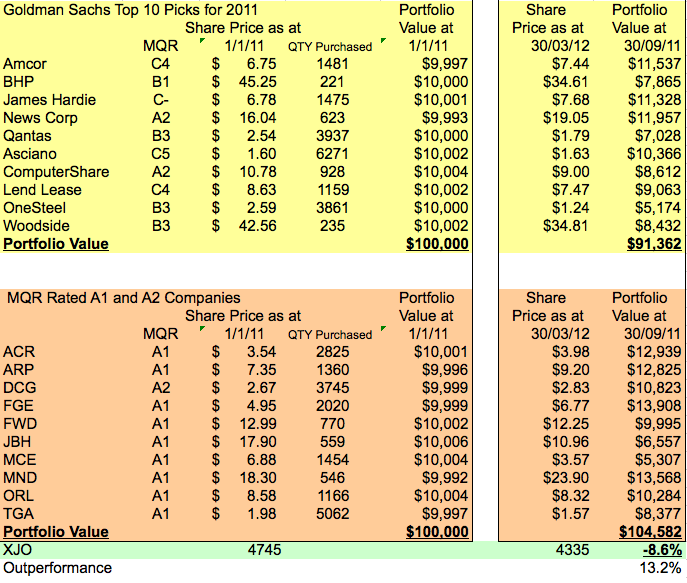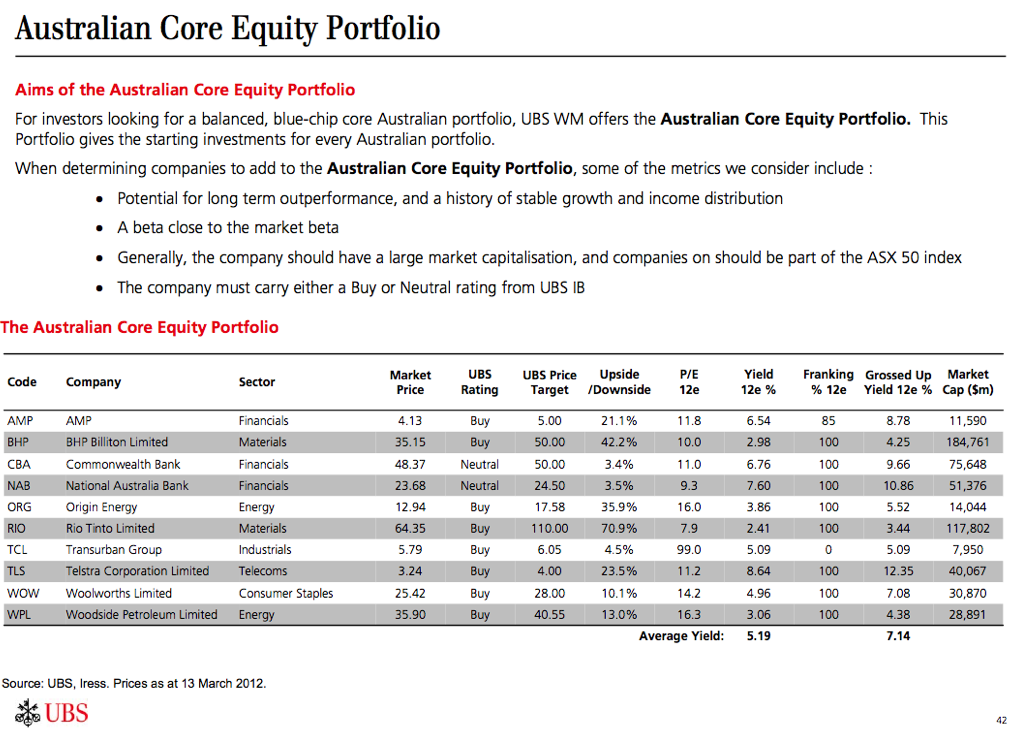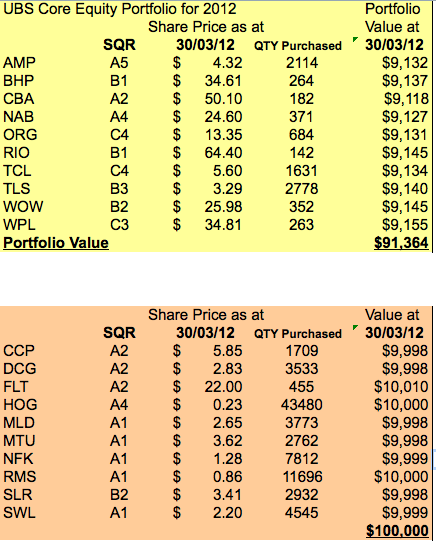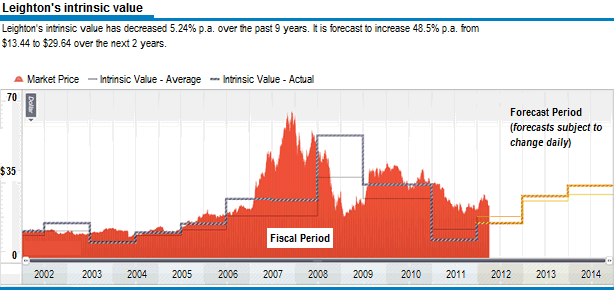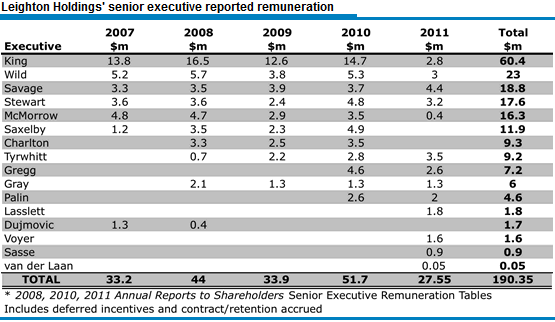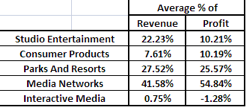Investing Education
-

MEDIA
What’s the Big Advantage in a high return on equity?
Roger Montgomery
May 1, 2012
In the May 2012 edition of the ASX Investor Update Email Newsletter, Roger Montgomery outlines his Value.able framework for successfully investing in the share market. Read here.
by Roger Montgomery Posted in Intrinsic Value, Investing Education, On the Internet, Value.able.
-
Guest Post: Can you beat the worlds biggest banks?
Roger Montgomery
April 19, 2012
 For new readers to the blog, welcome. Here at Roger’s blog we are conducting an ongoing study comparing the performance of investment portfolios recommended by major broking houses verses a loose selection of A1 and A2 stocks bought as a big a discount to IV as possible.
For new readers to the blog, welcome. Here at Roger’s blog we are conducting an ongoing study comparing the performance of investment portfolios recommended by major broking houses verses a loose selection of A1 and A2 stocks bought as a big a discount to IV as possible.(Its Roger here: Its important to understand this is a hypothetical investment portfolio based on one of the Twin’s consistent approaches to stock selection. In that regard it is not a collection of small high risk bets whose returns could be easily ramped. I will be very surprised if you see high double digit returns from such an approach for that reason. At Montgomery, managing +$200 million simply precludes us from investing in the small companies that would produce higher returns on relatively insignificant $5000 sums – irrespective of whether or not the returns can be boosted by disingenuous marketing by social media marketing experts or worse, even ramping. Its easy to make 50% per annum on $100,000. Much harder on $1billion. Even personally our individual speculative selections may have a couple of hundred thousand dollars allocated to them and so we are also precluded from employing capital where liquidity may be boosted only by the participation of a small group of invisible Facebook friends. Worse, our experience tells us that such anonymous groups can be a manic depressive bunch and when they’re told that a holding has been sold, the illiquid volumes of the companies they are toying with will produce the very opposite result of that which they aspired to achieved.)
We have been following twin brothers and their investment decisions and performances since December 2010.
The twins each inherited $100,000 and sought differing advice how to invest it, the quarterly reports of their investments can be found here:
http://rogermontgomery.com/will-david-beat-goliath/
http://rogermontgomery.com/how-are-the-a1-twins-performing/
http://rogermontgomery.com/which-a1-twin-is-outperforming/By the end of 2011 our first twin, the regional Queensland accountant was still head down, trying to help hundreds of clients recover from all the natural disasters of the previous 12 months, government help was available but so was the paperwork. As these tasks drew to a close, Queensland entered a bitter and hard fought state election, so comprehensive was the coverage, it was hard to watch anything else. There had been a lot on, and checking on the performance of his portfolio had really been at the bottom of the list.
Our NSW based public servant had pretty much had the same six months, but for very different reasons. Being in the Foreign Affairs office of the federal public service, he was now getting used to the third minister in 2 years, much changed, often needlessly and nobody had any time for anything other than redeploying resources and priorities.
As March ended and the weather cooled, both brothers had a chance for a bit of R&R and to catch up on personal business. Neither were particularly thrilled with the performance of their portfolio; Our public servant , who had always invested through Goldman Sachs had performed exactly in line with the broader market, his portfolio was down 8.6% over the 15 months, and had lost nearly $9 000. He felt he could do better, and had been thinking about getting other advice for quiet a while now, and decided to act. He now only had $91 000 left and decided to switch brokers and became a client of the giant international broking firm UBS, who provided him with their Australian Equity Core Portfolio. Here is an image of the advice from UBS and how his $91 000 was divided amongst the 10 stocks listed.
Source: March 2012 ASX Investor Hour. www.asx.com.au
Our Queensland accountant had faired significantly better, by investing in A1 and A2 stocks he had outperformed the market by 13.2% over the 15 months. However, he acknowledged that a couple of his investment decisions had performed poorly and wanted to rebalance his portfolio, he too decided to act. With over $104 000 available to invest he decided to round down his investable sum back to $100 000 and spend the surplus on a short Gold Coast holiday with his family and the balance on a membership to Skaffold. Skaffold is the research tool that would help him scour the every listed company to find quality stocks that may be selling at a price that offered a discount to estimated intrinsic value. Skaffold would also save him the time of sorting through ten years of annual reports for every listed company. Armed with ability to narrow down the choice of stocks, he would able to focus on the few that met his criteria and do further research on them before investing.
Here are the twin’s portfolios side-by-side:
The varying quality ratings of the 2 portfolios makes for interesting reading. On the basis of quality, the UBS portfolio doesn’t look very disciplined yet the portfolio chosen with the help of Skaffold looks pretty consistent. Except for 1 stock that is an A4. Our Skaffold user feels this cash flow positive producer may be about to be rerated by the market and A4 is as speculative as he could bring himself to be.
We will revisit our investing twins just after June 30 to see which portfolio is performing better, many thanks to Roger for putting the stocks to the test and actively encouraging this ongoing project.
All the Best
Scott TKeep in mind this is a hypothetical and educational exercise only and not a recommendation of any kind.
Authored by Scott and posted by Roger Montgomery, Value.able author, SkaffoldChairman and Fund Manager, 19 April 2012.
by Roger Montgomery Posted in Investing Education, Skaffold.
- 37 Comments
- save this article
- POSTED IN Investing Education, Skaffold
-
They may never be needed but are there enough?
Roger Montgomery
April 18, 2012
 Republished: PORTFOLIO POINT: Leighton’s recent performance issues have been exacerbated by a poor relationship between management and staff.
Republished: PORTFOLIO POINT: Leighton’s recent performance issues have been exacerbated by a poor relationship between management and staff.The 15th of April will mark the 100-year anniversary of the tragic sinking of the Titanic on its maiden voyage from Southampton England to New York. Owned by The Oceanic Steam Navigation Company or White Star Line of Boston Packets, the tragedy was not that her advanced safety features, which included watertight compartments and remotely activated watertight doors malfunctioned. The tragedy was the operational failure and that the Titanic lacked enough lifeboats to accommodate any more than a third of her total passenger and crew capacity.
It occurred to me on this anniversary that there are many lumbering, giant business boats listed on the Australian stock exchange today, whose journeys have been equally eventful, if not fatal, and whose management is no less responsible for operational failures and for providing lifeboats only for themselves.
Take the situation over at Leighton (ASX: LEI) – a company I wrote about here some time ago, saying: “There is a significant risk of downward revisions to current forecasts for the 2012 profit.” On March 30, the company wrote a further $254 million off its two biggest projects – Airport Link and the Victorian desalination plant. More broadly, Leighton downgraded its FY12 profit guidance to $400 million-$450 million from $600 million-$650 million, taking the company’s writedown tally to almost $2 billion in the past two years. This will reduce the return on equity from 22% to 15% for 2012, and significantly reduce the 2012 intrinsic value, which now sits below $14.00 (see graph below).
Source: Skaffold.com
Back when I wrote my prediction, I also noted that workers at the desalination plant had cited ‘safety concerns’ causing them to work more cautiously (read slowly) to ensure their physical safety and the safety of their $200,000 per year wage, which of course would not continue beyond the project’s completion.
This week, it was revealed that similar problems have emerged at Brisbane’s Airport Link project. According to one report, “an increasing level of aggressive behaviour” from unionised workers who wanted to “get paid for longer” was an attempt to “leverage this finishing phase” of the project.
Leighton must construct to a deadline, and liquidated damages clauses cost the company about $1.1 million per day for every day that the Airport Link project is delayed. My guess is that as a result of the workforce’s alleged ‘go slow’, Leighton is forced to bring in hundreds of sub-contractors such as sparkies (with “specialist commissioning skills and experience”, according to John Holland) to complete the work. Either way, it costs Leighton more. A 25% blow-out on a multi-billion dollar project can amount to $1 billion.
On top of these problems, Leighton has a $200 million deferred equity commitment to make two years after Airport Link opens. And if my speculation that the operator may be broke before Christmas comes to fruition, Leighton will be forced to write off another $63 million – the amount remaining to be written down.
But before you jump to attack the unions reported to be responsible for Leighton’s woes – something I believe is often justified, not because of what the unions represent, which is honourable, but because of the tactics they sometimes use to seek redress – you should remember that there are many companies whose more humble management works in harmony with its workforces, unionised or otherwise.
Management is an important part of the investment analysis mix and while I firmly believe, as Buffett does, that the business boat you get into is far more important than the man doing the rowing, I do also believe that management will make the bed that ultimately every stakeholder must lie in.
Any company whose management drives flash cars to the office, pays herculean salaries to themselves and/or takes advantage of company relationships for self-gain is always going to be the target of unrest and distrust from its staff. This is driven often by envy, a sense of unfairness or lack of equity, and while I am not saying this is the case at Leighton, clearly there’s something amiss that is the root cause of this much trouble.
Over the last decade, Leighton has generated cash flow from operations of $8.3 billion, but its capital expenditure has now exceeded $7.5 billion. This would leave $800 million for dividends, but the company has paid dividends of over $2 billion (perhaps to appease non-unionised, income-seeking shareholders who support the share price upon which management’s lucrative remuneration is based). Given the cash to fund this dividend largesse was not generated by business operations, $850 million of ownership-diluting equity has been raised and $1.3 billion of debt borrowed. And for this less-than-spectacular performance, the top 10 current executives were paid almost $20 million last year. Eight of those were paid more than $1.2 million in 2011, four were paid more than $2.3 million, and the year before, three of the 10 were paid more than $4.5 million each.
Forecast profits for 2012 will not be any higher than five years ago, and the company workforce has doubled to 51,281 employees at June 30, 2011. But $190 million in salaries for 15 senior executives (excluding van der Laan’s $47,000) between 2007 and 2011 (see table), while overseeing such performance does not sit well with staff (or vocal but ineffectual minority shareholders) and it’s the relationship between management and staff that is more than partly to blame for the company’s ills.
Whether or not the CFMEU’s Dave Noonan’s claim in The Australian Financial Review this week is correct – specifically that “the markets were the last to know [about Airport Link], everybody else in the industry knew that the company were going to drop hundreds of millions of dollars and obviously they chose to tell the stock market very late in the piece” – is less significant than whether a carcinogenic tumour has grown between management and staff. The former can be resolved but the latter is potentially more permanent, and therefore damaging to shareholder returns.
Leighton is a fixture in the portfolios of thousands of superannuants nearing retirement and their disappointment with their investment returns can be at least partly attributed to the poor wealth-creating contribution of this company and its management. In turn, this can be attributed to the motivation and satisfaction of staff.
Shareholders are also the owners and have a right to know how management is performing, but now the majority shareholder’s demands will hold sway and the majority shareholder is Spain’s Grupo ACS, not the many Australian super funds who thought the company’s management was working for them. Oh, and I am guessing there is the risk of further writedowns on projects that haven’t yet hit the headlines.
Like the Titanic, where only the executives at White Star Line were truly safe, minority shareholders may find there aren’t enough lifeboats for them either.
First Published at Eureka Report April 11. Republished and Posted by Roger Montgomery, Value.able author, Skaffold Chairman and Fund Manager, 19 April 2012.
by Roger Montgomery Posted in Companies, Energy / Resources, Insightful Insights, Investing Education, Manufacturing, Skaffold.
-
Guest Post: The Happiest Company on Earth?
Roger Montgomery
April 18, 2012
 Many of us grew up with a diet of the brilliant work of Walt Disney. As children we laughed and cried along with the characters of Donald Duck and Mickey Mouse, Cinderella and Bambi. More recently, boosted by the purchase of Steve’s Job’s Pixar business, Disney continues to build its library and draw many more generations into the fold with the characters of Finding Nemo, Toy Story, Monsters Inc and Cars. The company dominates with its ‘share-of-mind’ competitive advantage. In this Guest Post Andrew takes the scalpel to the company and dissects its major components.
Many of us grew up with a diet of the brilliant work of Walt Disney. As children we laughed and cried along with the characters of Donald Duck and Mickey Mouse, Cinderella and Bambi. More recently, boosted by the purchase of Steve’s Job’s Pixar business, Disney continues to build its library and draw many more generations into the fold with the characters of Finding Nemo, Toy Story, Monsters Inc and Cars. The company dominates with its ‘share-of-mind’ competitive advantage. In this Guest Post Andrew takes the scalpel to the company and dissects its major components.What does your company REALLY do?
A nuts and bolts look inside the happiest company on earthThe ability to make assumptions about the future prospects of a business is fundamentally linked to how we understand that business. Without a good understanding you will be more than likely flying blind and your perceptions and reality could be in very different places and therefore throwing a great deal of uncertainty into any estimate of intrinsic value (which is linked more to the future prospects than anything).
A company that I am very fond of and one that I am sure almost everyone here has heard of is the Walt Disney Company (NYSE:DIS). I thought this would make a great case study in understanding the business.
So what does Walt Disney do? The first thing that comes to mind is the feature cartoons that it made its name on and its theme parks. These are the most iconic images that are attached to this famous company and more than likely where we were first knowingly exposed to the brand whether it be entering Disneyland for the first time and looking up Main Street towards the castle or watching movies like Snow White, Dumbo, Pinocchio.
What may surprise some people however is that most of the revenue and net income for the company comes from television.
Take a look at the below table:
Figure 1-Yearly breakdown of DIS segment revenue and net income (net income is before non-controlling interests taken out and are reported in US$ Millions)
As you can see in Fig.1, every year from 2001 to 2011, the largest contributor to revenue and profit (except 2002) was the Media Networks segment of the business. Over this period the company has on average brought in around 41.5% of the groups revenue and 55% of the net income as shown by fig 2.Figure 2- Average % of total group figures
This technique of looking at the individual segment results and comparing them to the overall group is a technique I like to use to really understand the nuts and bolts of the business. Looking at these figures I can see that even though DIS made its name by animating feature cartoons and opening gigantic theme parks, it is the TV channels they own that make up the most crucial element of the business as it is today. There for if you were interested in investing in DIS you would be very wise to focus particular attention on understanding how the media Networks business derives its revenue and what risks are associated with this segment. Luckily the DIS annual report defines this in quite good detail but back to this later. One thing to realise though is that this type of analysis is greatly influenced by scale of operations. The biggest divisions will or at least should, bring in the bulk of the revenue and profits. It may be helpful to see on a relative basis at where the magic happens.To do this, you might like to use profit margins of each segment. It is not uncommon for a diversified businesses smallest division to have the highest profit margin as in Qantas with their frequent flyer division. Disney is no different. It can change from year to year as shown in figure 3 however. Once again as you can see, lately it has been about the media networks. Looking at this however, you can gain a clearer picture of the profitability of each division in a relative manner. Despite being one of the smallest divisions, the consumer products segment is right up there in regards to profitability.
Figure 3- Net margins by division and overall group
So now, simply by looking at the financials we can get a clearer picture as to what DIS is really all about. We can see that the media networks business is arguably the most important. I can also see that the parks and resorts division is a pretty predictable segment with revenue and profit growth pretty consistent throughout the years and whose margins remain quite stable.So where to next? Well you want to understand the risks associated with each segment so that you can be better placed to understand them and be able to make informed decisions and assumptions on the future. As mentioned earlier, the DIS annual Report actually goes into detail about the specific risks of each segment as well as detail as to how they derive their revenue. All annual reports will have a description of what the principal activities of the business are as well and if the management is shareholder orientated than it may include some very handy bits of information about the companies past, present and future. This is the next step, read all the information you can about that company whether it be through annual reports or newspaper articles, also read about the industry and read industry specific media to see what the insiders are doing and saying about the future. Knowledge is indeed power.
These are the simple steps to understanding a business and is aimed at the beginning investor although I think everyone can benefit from thinking more about how to understand a business they want to invest in.
Have you got any examples of businesses where the core operation may differ from what people may perceive? What gems can be found in the nuts and bolts of existing businesses? What techniques do you use to understand a new business? Feel free to post any thoughts below.
What do I think of Disney? Their return on equity has been increasing but is still below my required return so my valuation would still be at around or lower than their reported book value but I would love to own them personally. They are one of the biggest brands in the world and when they get it right, they create products that will last generations.
Guest Author: Andrew Leggett. Posted by Roger Montgomery, Value.able author, Skaffold Chairman and Fund Manager, 18 April 2012.
by Roger Montgomery Posted in Companies, Investing Education.
- 9 Comments
- save this article
- POSTED IN Companies, Investing Education
-
Guest Post: Do Something!
Roger Montgomery
April 18, 2012
 I spent Easter at the beach, getting away with my family and we enjoyed the company of a bunch of friends. The smallest children all like to build sand castles at the very edge of the dry sand where it becomes moist and pliable. Of course as the tide comes in they are constantly being forced back lest they find their monuments suffer from each mini-tsunami. Investors build their portfolios well back from the high tide mark and the relatively safety gives them the ability to gain perspective and see the tides for what the are.
I spent Easter at the beach, getting away with my family and we enjoyed the company of a bunch of friends. The smallest children all like to build sand castles at the very edge of the dry sand where it becomes moist and pliable. Of course as the tide comes in they are constantly being forced back lest they find their monuments suffer from each mini-tsunami. Investors build their portfolios well back from the high tide mark and the relatively safety gives them the ability to gain perspective and see the tides for what the are.In this Guest Post, Scott Green explores the merit of sitting further back and doing nothing.
Doing nothing whilst doing something
A value investing strategy requires discipline and patience over a long period of time to work succesfully. You can’t just be a value investor one week then jump to speculative investments the next and expect that the preservation and growth of capital over the long term will be adequate. Patience and discipline are linked inexorably and will take work to develop.
If you are anything like me you struggle with the urge to do ‘something’ in the market even when there is no real value to be found. As the days stretch in to weeks, the itch can become very tough to control and sometimes you just have to do something to alleviate the pressure. This is especially prevalent in markets that seem to be continually rising. You can think you are missing out even though your investment rules and/or Skaffold tell you that nothing is value. You can eventually ‘snap’ and relax your rules and trade, justifying your decision to yourself in any number of ways. Conquering this itch is an important step to becoming a succesful long term investor.
Doing Nothing
One of the key aspects of value investing that Roger has mentioned many times is switching off the stockmarket and focusing on businesses and investigating promising businesses for potential investment. However, in todays 24hr news cycle with information flying at you from every different angle it can be hard to completely switch off. Below I have detailed some steps that I have taken in my personal investment journey to reduce my exposure to the news cycle and also modify the way I do view items when I interact with them. Maybe they can assist you in your in you investment journey.
1) Keep your ‘value goggles’ on – When you do read a business article or watch an investment show, view it all through the prism of what you have learned in Value.able or elsewhere. You will be amazed at how simple it can become to quickly identify whether or not the relevant piece is helpful to you or of no value. You can save a lot of time reading the financial news if you avoid all the articles that involve speculation rather than investing. A healthy dose of skepticism probably goes hand in hand with the ‘value goggles’.
2) Avoid living on the business channels, websites and newspapers – Reading or viewing articles on the many available sources of business news is not itself unhealthy but, like fast food, living on it probably is. The popular image of the ‘investor’ is the man (or woman) in their office, big screen showing stockmarket prices and a fast paced business channel, a copy of some financial paper and a website screening the market for the latest breaking news and trends. As investors, we should use the media as a source of information but not allow it to dictate to us what we should or should not be doing. Of course, if Roger or a trusted value investor (Buffet, Klarman, Whitman etc.) is appearing on a show or writing an article that should be required viewing/reading.
3) Do not constantly check the stockmarket – Some people (I used to be one of them) know where the stockmarket is sitting at any given time throughout the day. They also know where their own portfolio sits in relation to this. They live and die every hour of the day depending on whether they are ‘up’ or ‘down’. As longer term focused investors, day to day fluctuations should be of no concern to us. You will find yourself a much more relaxed person if you track your portfolio once a month instead of once a day. To aid in this, avoid using the many free portfolio tracking services available on the web. Perhaps the biggest step is deleting the apps off your smart phone that will happily tell you how much you are worth every second of every day from anywhere on the planet. I found this the best thing I ever did in regards to switching off the stockmarket and controlling the ‘itch’.
Doing Something
This does not mean that we sit around in a vacuum waiting for ideas to just come to us, trade and then return to the void of nothingness. Instead, we replace the actions that hinder us with the actions that will assist us in our investment journey. These are some of the things that I do which progress my investment journey without inducing the urge to act.
1) Read good books on value investing – Many of us got our start in value investing through Value.able but there is a world of other great value investment books out there that can enhance your knowledge. The grand daddy of them all is, of course, Security Analysis by Benjamin Graham along with its easier to read brother The Intelligent Investor. Others I would recommend are Margin of Safety by Seth Klarman (if you can find it or afford it!), The Agressive Conservative Investor by Marty Whitman and You Can Be a Stockmarket Genius by Joel Greenblatt (Terrible title but the last word on special situations value investing). You should also read some of the books that detail specific situations, usually ‘investments’ that went wrong! Examples include When Genius Failed by Roger Lowenstein about the rise and fall of Long-Term Capital Managment, a hedge fund that collapsed spectacularly in 1998, and Liars Poker by Michael Lewis about the authors experience as a bond salesman at Salomon Brothers in the late 1980’s.
2) Read investor letters by trusted value investors – The annual shareholder letters of Warren Buffet are considered required reading by all in the invesment community but there are many others that are valueable sources of learning and, sometimes, ideas to pirate away and research some more. These can commonly be found on the websites of the respective investment funds, though there are other websites that collate the information. Also, they can sometimes get there hands on the more hard to find letters from the more private funds. The ones I like are Marty Whitman from Third Avenue Management, Seth Klarman of the Baupost Group and David Einhorn from Greenlight Capital.
3) Research companies – Probably the most important something you should be doing. Using Skaffold or other sources to generate ideas leads in to researching thses ideas to see if they are worth investing in. Indeed, most of my own ‘investment time’ is taken up reading company reports and balance sheets. some can be quickly dismissed as unsuitable whilst others will, after suitable research be deemed acceptable and join our portfolio. The research of companies is the heart of value investing and the only way to ensure that investments are made below intrinsic value and with a margin of safety.
Hopefully, the above ideas will assist you in your investment journey as the have assisted me. THey have helped me become a better, more disciplined, more patient and much more relaxed, investor. A soothing balm over the itch if you like.
Guest Post Author: Scott Green. Posted by Roger Montgomery, Value.able author, Skaffold Chairman and Fund Manager, 18 April 2012.
by Roger Montgomery Posted in Investing Education.
- 6 Comments
- save this article
- POSTED IN Investing Education
-

MEDIA
How can you beat the market?
Roger Montgomery
April 14, 2012
For many, beating the market indices is the hold grail of share market investing. In this Australian article published 14 April 2012 Roger Montgomery discusses how you too can beat the market using his Value.able investing strategy. Read here.
by Roger Montgomery Posted in Companies, In the Press, Investing Education, Value.able.
- save this article
- POSTED IN Companies, In the Press, Investing Education, Value.able
-

MEDIA
What are Roger Montgomery’s Value.able insights into Mining Services?
Roger Montgomery
April 14, 2012
Do New Hope Corporation (NHC), Northern Star Resources (NST), Mt Gibson Iron (MGX), Navarre Minerals (NMC), Allmine Group (AZG), Credit Corp Group (CCP), Matrix composites (MCE), Coffey International (COF), Data #3 (DTL), Breville Group (BRG), UGL (UGL), QR National (QRN) and Seymour Whyte (SWL) make Roger’s coveted A1 grade? Watch this edition of Sky Business’ Your Money Your Call broadcast 14 April 2012 to find out, and also learn Roger’s current insights into the Mining Services sector. Watch here.
by Roger Montgomery Posted in Companies, Energy / Resources, Intrinsic Value, Investing Education, TV Appearances, Value.able.
-

MEDIA
In April 2012 where does Russell Muldoon see good Value.able investments? (Part 2)
Roger Montgomery
April 10, 2012
Do Lonrho Mining (LOM), Integrated Research (IRI), Hawkley Oil and Gas (HOG), Boart Longyear (BLY), Forge (FGE) and Environmental CleanTechnologies (ESI) achieve Roger and coveted A1 grade? Watch Part 2 of Sky Business’ Your Money Your Call 10 April 2012 program now to find out. Watch here.
by Roger Montgomery Posted in Companies, Investing Education, TV Appearances, Value.able.
-

MEDIA
In April 2012 where does Russell Muldoon see good Value.able investments? (Part 1)
Roger Montgomery
April 10, 2012
Do Thorn Group (TGA), Maverick Drilling (MAD), Campbell Brothers (CPB) and Galaxy Resources (GXY) achieve Roger’s coveted A1 grade? Watch Part 1 of Sky Business’ Your Money Your Call 10 April 2012 program now to find. Watch here.
by Roger Montgomery Posted in Companies, Investing Education, TV Appearances.
- save this article
- POSTED IN Companies, Investing Education, TV Appearances
-

MEDIA
Can Apple’s share price continue to climb?
Roger Montgomery
April 3, 2012
Roger Montgomery discusses with Ticky Fullerton on ABC1’s ‘The Business’ how the ever-increasing climb of Apple’s share price is likely to come under pressure. Watch here.
This edition of The Business was broadcast 4 April 2012.
by Roger Montgomery Posted in Consumer discretionary, Energy / Resources, Intrinsic Value, Investing Education, TV Appearances.
